Trending
Opinion: How will Project 2025 impact game developers?
The Heritage Foundation's manifesto for the possible next administration could do great harm to many, including large portions of the game development community.
Mechanistry comms manager Michal Amielanczyk reveals the marketing strategy that helped Timberborn's popularity soar with only two years in early access.
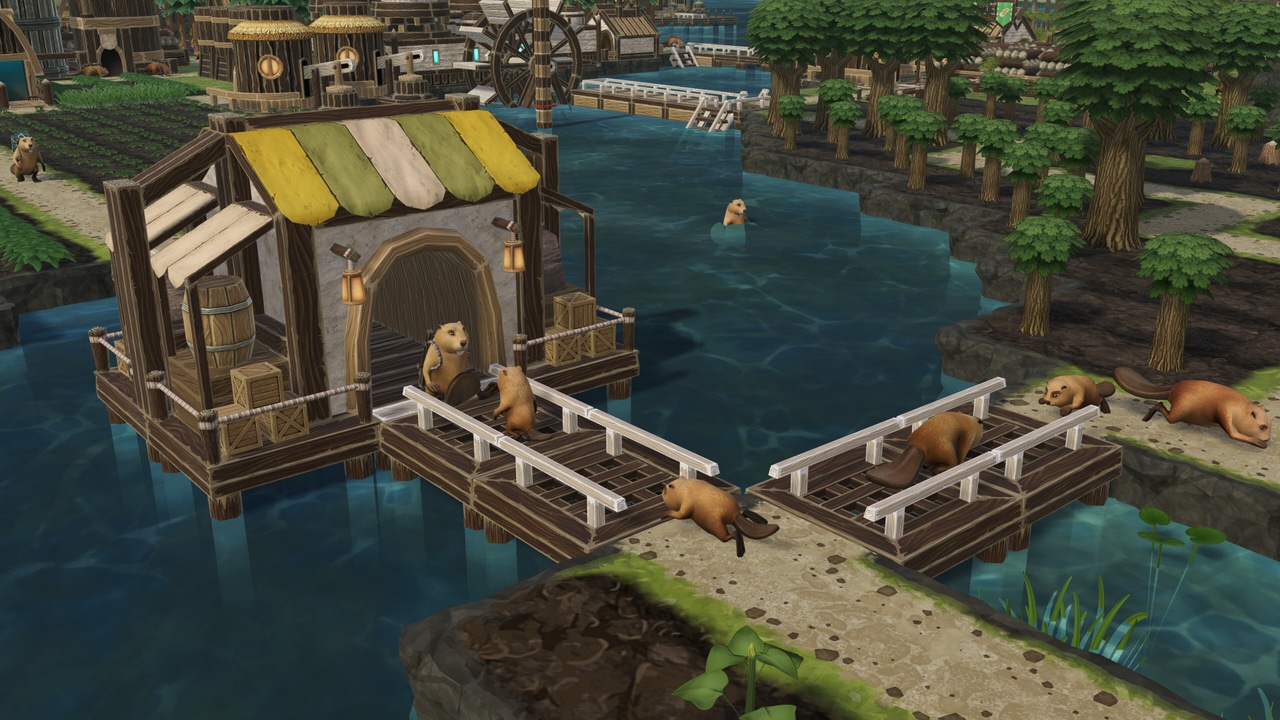
Game Developer Deep Dives are an ongoing series with the goal of shedding light on specific design, art, or technical features within a video game in order to show how seemingly simple, fundamental design decisions aren’t really that simple at all.
Earlier installments cover topics such as creating a game manual that accommodates multiple learning styles with director of The Banished Vault Nic Tringali, how Mimimi games crafted the save scum-friendly save system in Shadow Gambit: The Cursed Crew, and the technical work and creative nuances behind Slime Rancher 2's new weather system and the experiential impact that developers Monomi Park designed for players.
In this edition, Mechanistry comms manager Michal Amielanczyk reveals the marketing strategy that helped Timberborn's popularity soar with only two years in early access.
My name is Michal Amielanczyk, and I’m the comms manager at Mechanistry, the studio behind the beaver city builder Timberborn. Last year, I joined our game’s co-director, Kamil Dawidow, to tell you how we designed Timberborn’s water physics system. Today, I’m here to discuss the marketing strategy that helped us reach one million sales within two years and hit the highest post-launch player peak with our most recent content patch.
And here’s the game’s trailer so that you have a better understanding of how beavers and city-building mix in the game.
We went public with the game (and with the studio, since it’s Mechanistry’s first project) in October 2019 by launching the Steam page, social media channels, and opening the game’s Discord server to the public. Timberborn went into open alpha, and armed with a GIF and several bullet points, we pitched it to several content creators. Not long after, the indie devs’ messiah Splattercat picked the game up, marking the beginning of our marketing’s core effort—reaching the influencers.

It all began in a rather humble fashion as seen in this 2019 shot from Timberborn’s alpha version.
In the first year, the game went through a full redesign, received new visuals, and the open alpha was replaced with a closed beta. It was invitation-only, and the main way to grab a key was through contests held on our Discord, or through the newsletter. To help grow the Discord community, we also ran what we called “beaver brainstorms” —discussions focused on a single topic such as “What should be the next beaver faction?” As devs, we’ve always been active on Discord, and this continues to this day, with our server approaching 40.000 members.
We also started testing the waters with ads, beginning with Facebook. Sadly, while they worked well back then, we no longer consider them to be very cost-effective, with their main remaining advantage being the ability to precisely target the audience.

Okay, the game doesn’t support RTX but visual updates in Timberborn’s closed beta (2020) almost felt like it. Images via Mechanistry.
That first year proved to us that listening to the players’ feedback—such as making the vertical architecture much more important than originally planned—was a good idea. We also saw that content creators liked the game’s premise even in the early stage, and there was potential in the ads. What we were missing, however, was the real press coverage or the viral social posts all indie devs dream of. We ended the first year with about 17,000 wishlists.
In October 2020, we went for a game and branding update. The first iteration of the water physics system was added as the final missing unique selling point. The game also finally received its first real trailer, and that lovely key art where everyone saw a beaver-y Donald Trump (not our intention).
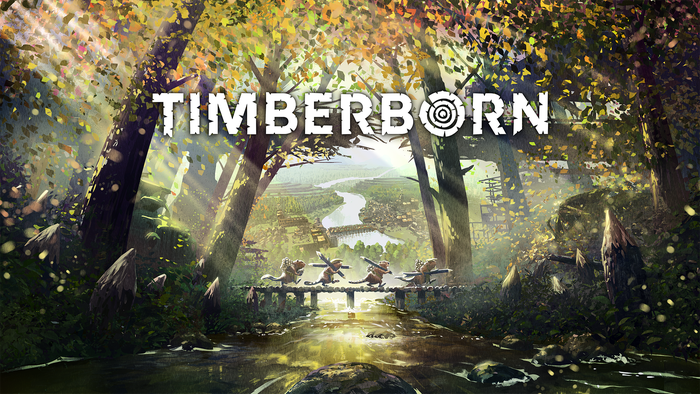
The OG Timberborn key art (2020). Images via Mechanistry.
With the press kit rounded up, we reached out to the press and pitched Timberborn as if it was the first time we contacted them; it looked and played so much differently, after all. We also started a wider organic influencer reach out. Both initiatives resulted in some coverage, and we also finally landed viral-ish posts on Reddit (800+ upvotes on /indiegames, 500+ on /indiegaming). We even reached the front page of a Polish Reddit-lookalike Wykop.
To respond to the amplified interest, we also started a more organized distribution of Steam keys for the beta, using Keymailer and Woovit. We also tried the next ad channels, Reddit and Twitter, but the results were middling at best compared to then-successful Facebook ads.
The above led up to Timberborn’s breakthrough at Steam Next Fest in January 2021. We ended the closed beta shortly before that, and for the Fest, we launched the game’s demo featuring much-needed updates, including the current beaver models and the addition of droughts.

The demo finally saw the game’s modern look, including the current beaver models (2021). Images via Mechanistry.
The demo included the very prominent “Wishlist now!” and “Feedback” buttons; locked content was there but grayed out, and the playthrough would end with an easy-to-share summary screen. (As it turned out, it was really easy to cheat the system and continue playing with the cycle limit bypassed, but when people did that so eagerly, we saw that as a good sign).

Perhaps not the prettiest UI ever, but the demo’s Wishlist now! buttons and the endgame stats really helped us gain traction ahead of launch. Images via Mechanistry.
To support the demo, we launched regionally targeted Facebook ads and sponsored some content with genre-specific creators such as Blitz. We finally managed to land a viral Imgur post with the classic "2.5+ years in the making and our beaver city builder has a demo", reaching 100,000 views. This is also when looped live streams became the norm on our Steam page.
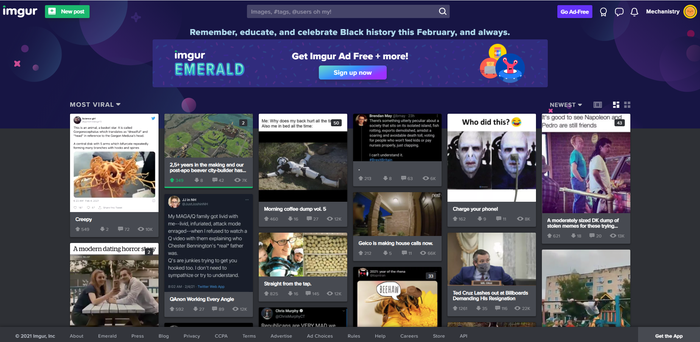
Ah, the golden grail of game marketing back in the day - landing on Imgur’s front page. Images via Mechanistry.
In the end, Timberborn demo was the third most played demo of the fest with over 100,000 players, and within three weeks, we were up 91,000 wishlists. We were overjoyed.
The launch was in sight. In June 2021, at Future Games Show— which somehow got Timberborn labeled as a "game shown at E3"—we had a 30s reveal segment that we estimate yielded about 7,000 wishlists. After that, we joined several Steam events, such as the World Nature Conservation Sale (courtesy of the awesome folks at Breaking Walls), which earned us about 8,000 wishlists.
The two key pre-release marketing beats ended up happening on the same day at Gamescom 2021 (welp). Within two hours, we revealed the second in-game beaver faction at Awesome Indies by IGN, and announced the launch date at the PC Gaming Show by PC Gamer. 17,000 wishlists were added that week, and the launch was three weeks away. We set up the date reveal trailer as a YouTube ad (which worked) and prepared some traditional Google text ads (which didn’t).
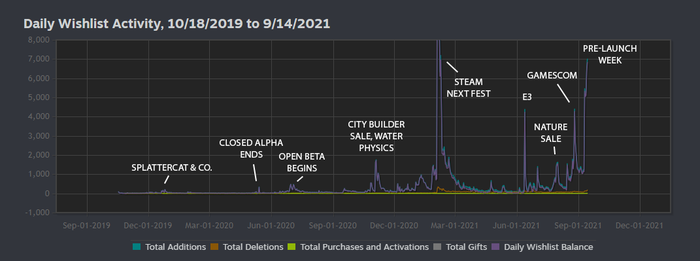
Pre-launch, we had about 261,000 wishlists, 244,000 of them collected in the final 12 months. Images via Mechanistry.
In the final week’s effort, we built up the hype with seven Steam posts, published daily, with each article covering a different aspect of the game. In that week, 32,000 wishlists were added, and finally, on September 15, 2021, Timberborn Early Access launched with a total of about 261,000 wishlists. What followed was the madness nobody at our seven-person studio had expected.
For starters, we learned the hard way that our launch hour, 4 PM CET, was not optimal. You see, that green "Launch" button on Steam broke when we clicked it and it took down our store page. We guess it happened because of our last-minute meddling in the backend, and we spent about half an hour trying to get the situation solved while the players and influencers were growing confused. Finally, some good souls at Valve helped us remedy the situation, even though it was way before their office hours.
For launch, we lined up our first Twitch Bounties campaign, as well as directly sponsored 13 content creators, eight of them English-speaking. We went for Twitch creators with 300 to 1800 average concurrent viewers on Twitch and the YouTube creators with 50,000 to 150,000 views per video. Here’s a tip: two weeks might not be enough to sign all the contracts.
We handled the press reach out ourselves, simply messaging all major outlets we could find and uploading the press release on GamesPress. Just like with content creators, we stuck to a short email with a GIF, and, at least when messaging the larger outlets, we included Steam release override keys right in the emails so that they would be able to play Timberborn before launch. In the end, the game’s release was covered by Kotaku, PC Gamer, and Polygon.
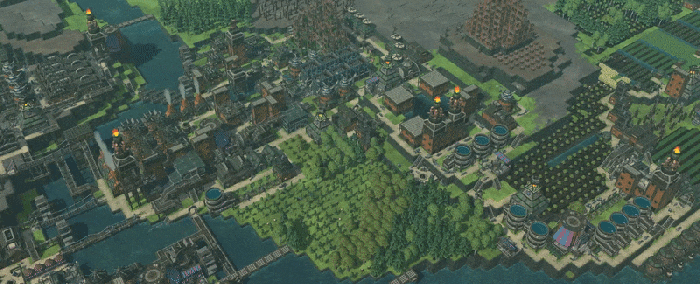
The simple GIF we used in our emails at launch (along with the bulleted list of the game’s features and a Steam override game key). Images via Mechanistry.
As soon as we saw the first sales and traffic data, and it was clear the game caught on (and the studio was not going under), we frantically tried to secure more creator coverage for the weekend. This included another batch of Twitch Bounties as well as some late-night messaging with influencer agencies to guarantee more live streams. Strike while the iron is hot, as they say.
All that resulted in a sales peak during the weekend, as well as the all-time high player peak of over 12,300 players. In the first week alone, the game sold 130,000 copies, which we announced with a “Thank you” post meant to stay up on Steam and build good vibes while we were recovering from the shock and getting back to work. That’s also the moment when many developers would post a roadmap for the game, but we decided against that.
While we do have an internal roadmap, the closest public resource we use is the FeatureUpvote hub where our players vote for the most pressing issues, which we then mark as “Under consideration”, “Done” etc. Over two years later, we stand by the no-roadmap policy. Some players may not like us being so tight-lipped, but we’d rather do that than promise something and then start delaying stuff when it becomes clear attention is needed elsewhere.
Timberborn’s second concurrent players' peak of around 10,900 came in January 2024, with the highly marketed, content-filled release of Update 5, Badwater. We’ve tried different approaches but collecting the game-changing features into large updates, released about twice a year, and going live with the biggest possible oomph works best for us.
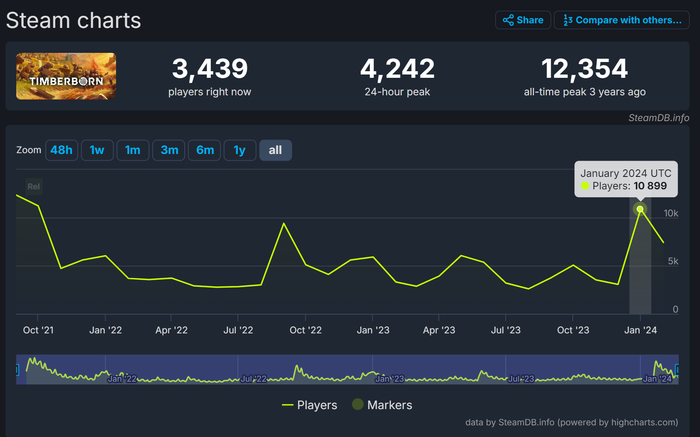
Update 5 released in January 2024 resulted in the highest player peak since the game’s launch in 2021. The bump in the middle is Update 2 (September 2022). Images via Mechanistry.
Update 5 is an evolution of what we did with Update 1, released three months after launch. The goal behind U1 was to set the players’ expectations regarding the cadence of updates. That’s also where we settled on the 20% discount we maintain to this day (that’s the threshold for email sendouts on Steam). Whenever we launch a major update, we try to secure a front page featuring on Steam. If a cooldown gets in the way, or all spots are taken, we’ll move it around.

The traditional display ads are the minority of what we do, but for the most important campaigns, we also use them on top of YouTube (and now also TikTok) ads. Images via Mechanistry.
Most importantly, Update 1 is when we started testing things on the Experimental Branch. That’s where all our updates, from the smallest hotfixes to major content patches, land first. While only about 10% of our player base uses this testing branch, these are our most devoted players, and we treat their feedback extremely seriously, reworking new features as needed.
The feedback gathered on the Experimental Branch helps us refine the gameplay so that when the general public gets to play, the experience is enjoyable and (mostly) bug-free. However, the perception between these two groups may differ. When we launched Update 5 - Badwater, we believed the titular challenge to be in a good place difficulty-wise. As it turns out, the new and more casual players found it to be too brutal, so we needed to implement some extra tweaks.
Now, the Experimental Branch also has its problems; while it’s announcement material by itself, it somewhat steals the thunder from the more important main branch news. Many people have already seen the new content, after all, and it makes it difficult to offer any pre-launch exclusivity to content creators or the media—and that’s what gets your game featured.

Here’s what each of our campaigns consists of, with the circles’ sizes roughly corresponding to how much of my time everything consumes. Images via Mechanistry.
Our two most successful campaigns were for Update 2 (September 2022) and Update 5 (January 2024). Both of these updates are focused on visual, easy-to-explain gameplay features (Update 2—beaver bots and terraforming, Update 5—the liquid toxic waste called badwater, and a related in-game season). That makes marketing them much more effective.
For both campaigns, we spent most of the marketing budget on a selection of content creators—we typically try to invite about 66% new faces, with the rest being a selection of Timberborn vets. The remaining budget goes towards the ads —as of February 2024, what works best for us are YouTube ads and TikTok ads (boosting existing posts with an added link).
I’ve been circling around the topic, but here’s why we think cooperation with content creators works for us.
Timberborn is highly replayable.
Its USPs (beavers, water physics, vertical architecture, droughts, bad tides) easily impress.
It takes a moment to build an awe-inspiring city and see all the cool content. The creator, liking the game, will devote their time and actually reach (and show) that.
The gameplay allows for dramatic comebacks and memorable moments (for example, the drought or badwater killing the crops while the creator does their best to salvage the situation).
The game appeals to a wider audience; it can play both as a challenging, complex sandbox city-building game, and a cozy sim with cute beavers chilling in a mud bath.
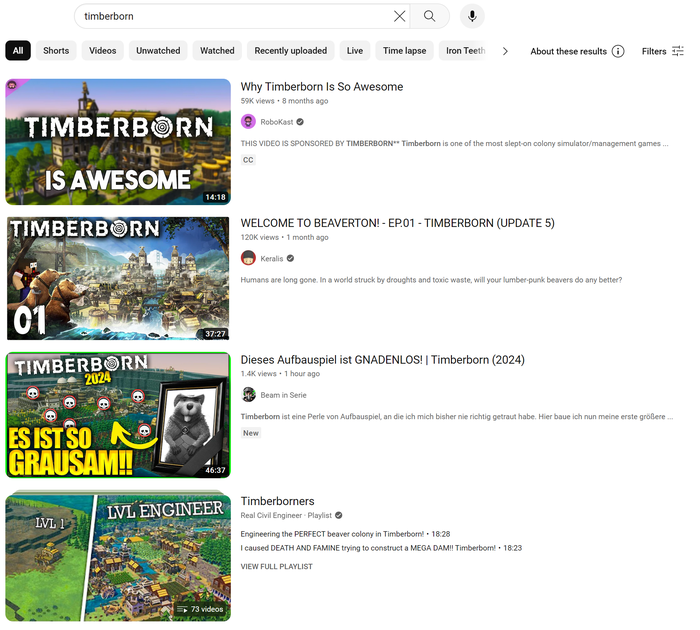
Seeing new, popular Timberborn videos pop up on YouTube is easily among the most thrilling experiences in my job. Images via Mechanistry.
And, to add some extra bullet points, here’s how we work with the creators.
We aim for mid-sized ones, which I’d define as 250 to 1,000 average viewers (Twitch) and 25,000 to 100,000 views (YouTube). We’re always trying to select relevant creators who have played the genre; if someone is huge but exclusively streams GTA 5, we’ll pass.
We try to spread out the sponsorships to boost the weekend traffic. This usually means releasing the update on Thursday, with the coverage from Thursday to Sunday.
We ask the creators to share the link to the store page; if they use a bot, send them UTM links, as that’s what Steam tracks.
We ask them to play or link the official feature trailer for the update.
Sharing proposed talking points is okay, but we never censor the videos or police the opinions. If a creator wants to send us a video for approval, that’s great, but it’s not a must, and we never ask them to redo anything unless there’s something totally wrong (such as that one time when the update-focused video was recorded on the non-updated game).
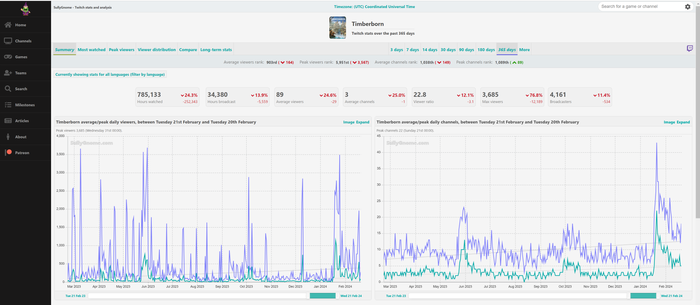
In my opinion, SullyGnome is the best (not just because it’s free to use) tool to check on our game’s performance on Twitch. Highly recommended! Images via Mechanistry.
On top of Twitch Bounties, which are great for a quick setup but have dropped in effectiveness for us, there are several useful tools we use to invite content creators to check the game out, such as Woovit, Keymailer, and Lurkit. Sadly, you need to be very careful with those; there are tons of scammers out there, requesting free keys and getting quite creative with setting up fake channels. In my opinion, the absolutely best way to look up the creators (and the game’s performance afterward) is SullyGnome, at least for Twitch.
Before I wrap things up, here are some extra thoughts on what we do between the major updates to keep the interest (and sales) up.
First, we discount the game often, and we’re always looking for opportunities to join themed sales on Steam. All officially endorsed sale events (not only the big seasonal ones but also themed events such as SimFest) are no-brainers. For the sales and events created by external partners, they’re great if they receive the front page feature. If not, we may hesitate.
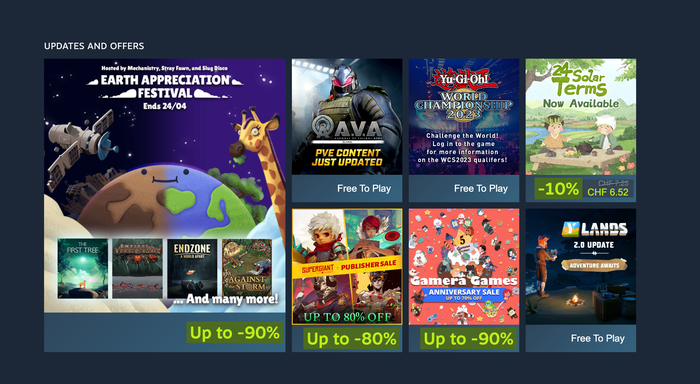
Earth Appreciation Festival 2023 - just like its 2022 edition - landed on Steam’s front page. That’s what makes or breaks a sale. Images via Mechanistry.
Speaking of which, for the past two years, we’ve been organizing our own Steam sale, the Earth Appreciation Festival (in 2023, the great people at Stray Fawn and Slug Disco helped us). A curated event like this takes lots of work to set up, and you need to start preparations at least three months in advance, but if you manage to invite great games and pitch them to Steam, you may end up with a cool event that results in higher sales (and in our case: 15% of the revenue benefitting the charity). All the networking you do in the meantime is just a cherry on top.
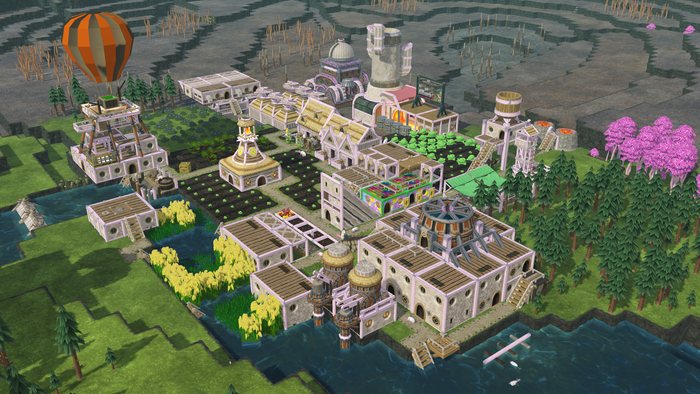
Water Beaver Overhaul by lapantouflemagics one of the most extensive mods for the game created by our players. Images via Mechanistry.
The time between the updates is also when we focus on activating our community; right now, for example, we’re running the third edition of a map-building contest (with prizes!). In the past, we posted devlogs, created showcases of player-made mods, and even got into more crazy stuff. In 2022, we asked the composer of our OST, Zofia Domaradzka, to create an arrangement of a 19th-century sea shanty, for which our community members wrote (and sang) Timberborn-themed lyrics. And even though that didn’t directly translate into better sales, it got us and the community closer (and earned me one of my most vivid work-related memories).
Other than that, it’s indie game marketing 101, from joining competitions for indie devs and optimizing the store page to getting a fancy new trailer and finding great bundle opportunities (hi, Dwarf Fortress!). But that’s the matter for another article, and I’ve kept you here long enough. Plus, I need to check our Discord for more dank beaver memes.
Thanks for reading!
Read more about:
Deep DivesYou May Also Like